Special Feature: Products Sally Recommends
"Pass the Nyapi, Please!"
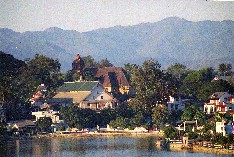 In
the states, you will be lucky to find a Burmese restaurant where you live. It
is one of the few cuisines that Americans have not yet discovered, so you can
imagine how excited two food consultants were as they booked their trip to Myanmar.
We felt a little like Columbus, sent to explore previously uncharted territories.
In
the states, you will be lucky to find a Burmese restaurant where you live. It
is one of the few cuisines that Americans have not yet discovered, so you can
imagine how excited two food consultants were as they booked their trip to Myanmar.
We felt a little like Columbus, sent to explore previously uncharted territories.
After spending a few days in the capital of Myanmar, Yangon (also known as Rangoon), we weren't much closer to unlocking any culinary secrets. We had eaten some tasty Chinese food, dined on some fancy French food, and even stumbled across a Mexican wine bar…but where was the local food? After querying everyone we met, the general consensus was that Shan state had the best traditional food.
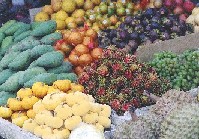 Hope
sprang eternal as we excitedly boarded the plane for Khentung-the old Shan capital.
Although the flight took only a few hours from Yangon, when we landed we felt
like we had gone back 100 years in time. Khentung is built in a valley around
Nong Tung Lake, and is surrounded by picturesque green-clad mountains. Numerous
Buddhist temples (known as stupas) and monasteries add to the quiet beauty and
peaceful serenity which is most welcome after the hustle of Yangon.
Hope
sprang eternal as we excitedly boarded the plane for Khentung-the old Shan capital.
Although the flight took only a few hours from Yangon, when we landed we felt
like we had gone back 100 years in time. Khentung is built in a valley around
Nong Tung Lake, and is surrounded by picturesque green-clad mountains. Numerous
Buddhist temples (known as stupas) and monasteries add to the quiet beauty and
peaceful serenity which is most welcome after the hustle of Yangon.
Our travel agent had booked us at the Princess Hotel, right in the center of town. Although rather basic, it was impeccably clean, and the General Manager did everything possible to ensure our stay was enjoyable. When he found out we were writing about Burmese food, he quickly ordered the cook to forget about the standard fried egg breakfast, and prepare us Shan soups.
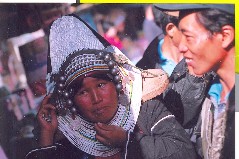 The
first night we ate at the Golden Banyan. We pre-arranged to have a Shan dinner
prepared, and the chef rallied to the occasion. Although the atmosphere of this
open-air restaurant may leave something to be desired the food certainly does
not. Meals are a communal affair, with everyone sipping out of the same serving
spoon and using their right hand to scoop up a handful of food. We began with
a pot of vegetable soup-made up of a potpourri of market vegetables, seasoned
with a unique blend of herbs and spices. One of our favorite dishes was Ne Sa,
a mound of minced pork that was sautéed with shallots and chili surrounded
by a bed of crunchy cabbage, scallions, chive root, and herbs and accented with
crispy fried onions and dried shrimp. We were impressed with the beautifully presented
Lakai en rok care, an elegant, deep-fried local flower stuffed with delicately
spiced minced meat. The colorful vegetable stir fry was lightly kissed with a
touch of garlic and chilies. We ladled this over piles of fragrant sticky rice,
debating the merits of the white versus the brown rice. (Later we tasted the black
sticky rice and had a new contender) This was where we first encountered the ubiquitous
nyapi. The Shan people can't make it through a meal without copious spoonfuls
of nyapi-a hot seasoning paste based on fermented fish or shrimp. After our first
taste, we were immediately hooked. We even began carrying small containers of
our favorite nyapi with us in case our food needed a fix!
The
first night we ate at the Golden Banyan. We pre-arranged to have a Shan dinner
prepared, and the chef rallied to the occasion. Although the atmosphere of this
open-air restaurant may leave something to be desired the food certainly does
not. Meals are a communal affair, with everyone sipping out of the same serving
spoon and using their right hand to scoop up a handful of food. We began with
a pot of vegetable soup-made up of a potpourri of market vegetables, seasoned
with a unique blend of herbs and spices. One of our favorite dishes was Ne Sa,
a mound of minced pork that was sautéed with shallots and chili surrounded
by a bed of crunchy cabbage, scallions, chive root, and herbs and accented with
crispy fried onions and dried shrimp. We were impressed with the beautifully presented
Lakai en rok care, an elegant, deep-fried local flower stuffed with delicately
spiced minced meat. The colorful vegetable stir fry was lightly kissed with a
touch of garlic and chilies. We ladled this over piles of fragrant sticky rice,
debating the merits of the white versus the brown rice. (Later we tasted the black
sticky rice and had a new contender) This was where we first encountered the ubiquitous
nyapi. The Shan people can't make it through a meal without copious spoonfuls
of nyapi-a hot seasoning paste based on fermented fish or shrimp. After our first
taste, we were immediately hooked. We even began carrying small containers of
our favorite nyapi with us in case our food needed a fix!
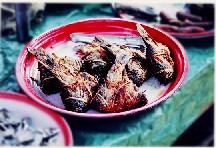 *Two
important caveats: the Burmese use excessive amounts of oil when cooking. They
feel it is insulting to their guests to do otherwise. After requesting that our
food be made with only a little oil-and finding out that "a little"
meant something quite different to them, we asked for "No Oil" and were
extremely satisfied with the results. The other warning is to be sure and ask
for food to be prepared "without Ajinomoto", which is MSG.
*Two
important caveats: the Burmese use excessive amounts of oil when cooking. They
feel it is insulting to their guests to do otherwise. After requesting that our
food be made with only a little oil-and finding out that "a little"
meant something quite different to them, we asked for "No Oil" and were
extremely satisfied with the results. The other warning is to be sure and ask
for food to be prepared "without Ajinomoto", which is MSG.
For
our last night in Khentung we invited our guide and his wife out for dinner. When
we found out that she had never eaten in a restaurant, we knew we wanted to take
her someplace special. Most Burmese prefer Chinese food when dining out so we
selected Lod Htin Lu restaurant. We were a little disappointed when we walked
in -but behind its characterless façade lay a very accomplished kitchen.
Not only was it the best Chinese food we had in all of Myanmar, it was better
than most Chinese food in China! After slurping up a richly seasoned vegetable
soup, we knew we had picked the right restaurant. Every dish was exemplary. The
mouth-watering lo mein noodles were firm and virtually grease-free. They were
generously topped with toothsome pork and assorted fresh vegetables. The hot and
sour chicken was made with velvety chicken pieces infused with garlic and ginger
and a hint of chili. We quickly devoured a deceptively simple dish of homemade
tofu and mixed mushrooms. The seasonal greens were quickly sautéed retaining
a slight crispness, and served with a light garlic sauce, that enhanced but did
not overwhelm their delicate flavor. It's easy to be virtuous when dessert choices
consist of perfectly ripe slices of pineapple or orange quarters. A meal at either
of these restaurants costs about $6 for 4 people and will provide you with enough
food to feed eight. After such a delightful meal I don't think this is the last
time the guide's wife will be dining out!
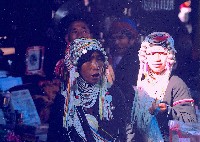 With
all this eating, some sort of exercise is mandatory. Taking day treks to visit
the local hill tribes is an excellent way to burn off some extra calories. Our
favorite guide, Mr. Paul, not only speaks fluent English, but also knows most
of the dialects of the local tribes. He contributed greatly to our visits by explaining
the different tribal customs and religious beliefs. He was extremely concerned
with the welfare of the tribal people and we were happy to help support his efforts
by providing them with basic medicines, pencils, and notebooks.
With
all this eating, some sort of exercise is mandatory. Taking day treks to visit
the local hill tribes is an excellent way to burn off some extra calories. Our
favorite guide, Mr. Paul, not only speaks fluent English, but also knows most
of the dialects of the local tribes. He contributed greatly to our visits by explaining
the different tribal customs and religious beliefs. He was extremely concerned
with the welfare of the tribal people and we were happy to help support his efforts
by providing them with basic medicines, pencils, and notebooks.
Since no food was available where we trekked, a picnic lunch was in order. Starting off each day with a trip to the market, we felt just like the locals, as we cheerfully elbowed our way through the crowds, visiting our favorite vendors, squeezing and sniffing the fruit to make sure it was at peak ripeness. Every day we'd try a different sausage or jerky to go with our sticky rice selection, and a salad-perhaps made from freshly chopped sweet tomatoes, onions and chili sauce-all packed in pristine little plastic take-away bags. Instead of our usual ketchup and mustard, here our favorite condiments were a salty piquant sauce made from pickled mustard greens, an intense smoky aubergine spread, or sour slivers of fermented bamboo shoots (an acquired taste). For dessert, we would wander over to the fruit stalls and buy a pomelo, which looked like a grapefruit on steroids, a cluster of huge grapes from China, or a bunch of finger bananas. Holding our noses, we decided to skip the durian!
Hearts and stomachs heavy, we sadly boarded our plane 4 days later. We could have happily spent another week exploring Khentung, but our plans called for stops in Kalaw, Inle Lake, Mandalay, and Bagan, before returning to Yangon. During the next few weeks we'd partake of many delicacies. We would feast on the appropriately named "Suffering Fish," a lake fish that is painstakingly skinned, de-boned, pounded, seasoned and then stuffed back into its skin. We'd slurp mohinga, the famous fish soup that is the Burmese breakfast of champions. At a scenic restaurant overlooking the river in Bagan, we crunched the heads off the sweetest, most impeccably fresh prawns imaginable.
Khentung is a living picture-perfect postcard, with a plethora of fascinating tribal people to visit. But for two food consultants, in search of uncharted cuisines, it was a dream come true. After eating such beautifully prepared meals, home-cooked or at restaurants, and sampling from the endless array of exotic foods at the market, we concluded that Khentung was indeed the culinary mecca of Myanmar. We highly recommend that all foodies make this pilgrimage at least once in their lives. Just be sure to pack a pair of pants with an elasticized waistband!
*Special
thanks to Myriam Grest, owner of Myanmar Travel Ltd, who organized our entire
trip. More information about our itinerary, hotels, and prices can be found by
contacting Myriam at:
Myanmar Travel Ltd.
Pansodan Office Tower, 3rd Floor,
Room 3A
189/195, Pansodan Street, Kyauktada Township
Yangon, Myanmar
Tel.:
(+951) 204-046, 243-125; Fax: (+951) 243-125
E-mail:
info@myanmartravel.net
Hotels
Yangon:
Traders Hotel/deluxe ****
Kyaikhtiyo: Golden Rock Hotel/deluxe **
Khengtung:
Princess Hotel/standard * ½
Kalaw: Kalaw Hotel/superior **
Inle
Lake: Hupin Hotel Kaung Dine / superior ***
Mandalay: Sedona Hotel/superior
****
Bagan: Bagan Hotel/suite *** ½
Airlines
Air
Mandalay
Yangon Airlines
Janice Nieder and Rebecca Sparks are co-owners of Food & Travel, a bi-coastal venture. While others make dinner reservations, they make plane reservations in search of a truly memorable meal. Janice is a San-Francisco based Food & Fitness Consultant, with an insatiable culinary curiosity. Rebecca is a nutritionist and cooking teacher who makes sure that food is not only healthy but more important tasty.
Note: This information was accurate when it was published. Please be sure to confirm all rates and details directly with the businesses in question before making your plans.



